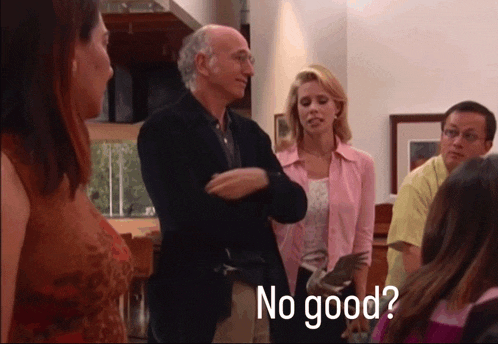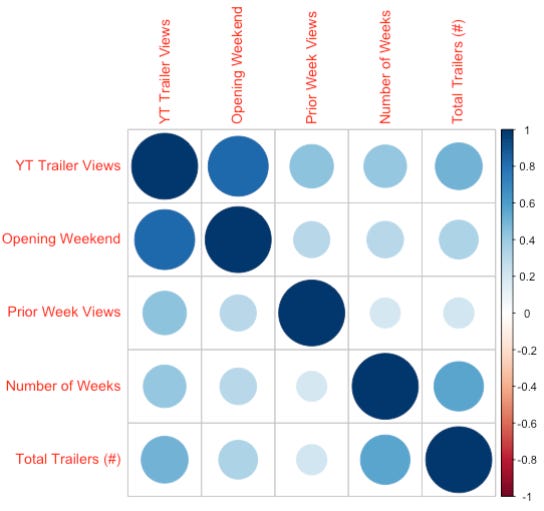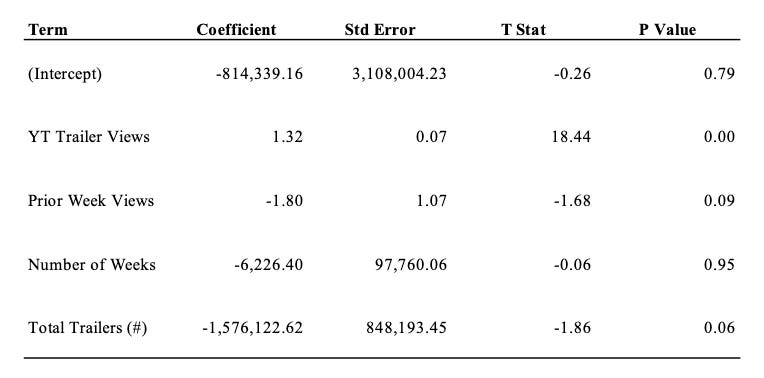THIS JUNE
IN A WORLD, WHERE BOX OFFICE REVENUE HAS DRIED UP AND TECH BILLIONAIRES CAN NO LONGER BUY ANYTHING THEY WANT, ONE MAN HAS THE POWER TO DISTRACT YOU WITH SOMETHING SO MUNDANE, IT JUST. MIGHT. WORK.
Okay, that was my terrible attempt at a Don LaFontaine opener. Did it work?

Today, we’re going to be talking about movie trailers. The history, qualities, and data. Trailers are meant to raise awareness, build intrigue, enter the zeitgeist, and ultimately put butts in seats. Or maybe put 1 eyeball and 1.5 ears on a medium sized screen, while the other senses are are working overtime trying to keep track of a baseball game on a much smaller screen in one hand and a half eaten banh mi in the other hand (totally not me).
Movie trailers have changed much since their inception in 1913, much like the movies they promote. As the entertainment business has indexed heavier on the “business” and less so on the “entertainment,” trailers are more of an advertising cost and less of a spectacle themselves. I’ve always loved trailers, and admittedly still do. As a kid, I would bug my parents to get us to the theater in advance of the showtime to watch the trailers on the big screen.
I still rush to get to the theater early. And I still make the mistake of eating my entire trough of popcorn and gallon jug of ICEE (Coke, Cherry, Blue Raspberry mix of course) before the movie even starts.
The History
The first trailer was actually for a Broadway musical, The Pleasure Seekers, in 1913. Unfortunately, I couldn’t track down a copy of the video, but apparently it was a bunch of rehearsal footage spliced together, which was shown after films at the Marcus Loew theaters. Hence the name “trailers,” because they “trailed” the films (wild how things stick).
I was able to track down the video for the first “talkie” trailer, a strange promotional trailer for the 1927 Warner Bros film, The Jazz Singer. I won’t include a link to this trailer, and I’ll explain why.
The Jazz Singer is famous… and infamous. It was the first feature-length film to use synchronized sound. A major gamble by WB, the sound was recorded separately on wax cylinders (a Thomas Edison invention), and then played alongside the film for select scenes.
A major technological breakthrough, The Jazz Singer is not without controversy. The film is about a dreamer, played by Al Jolson, who was estranged by his cantor father after said dreamer wants to become a jazz performer. It sounds like a film with prodigal son energy (can’t say I’ve seen it). What took me aback watching the trailer, and the reason why I did not include the video link, is the disturbing use of blackface throughout the film. I didn’t expect a blog post on movie trailers would lead me to this, but I guess that just shows how “the history of the entertainment industry is more closely intertwined with blackface than anyone would like to admit” (MovieMaker).
I’ll now breeze through the different eras of trailers, with a few choice examples that are emblematic of the entertainment industry at the time, and the artists involved in its creation. Note: I’m not a film historian (surprise!), so my elementary descriptions will probably cause many to scoff. Bear with me.
1920s - 1950s: Title cards, Score, and News Anchor-esque Narrators
1960s - 1970s: What the F*ck Did I Just Watch, I Have to See the Movie
1980s - 2000s: Montages, VHS, and Don LaFontaine-esque Narrators
2010s - 2020s: Tell Me the Whole Plot so I Don’t Have to See the Movie
Now I know that this is painting with broadest brush possible, and I apologize for spamming your screen with trailers. I had a lot of fun exploring the trailers by decade and seeing their evolution over time, so hopefully you share my enjoyment.
Maybe it brought back some memories from seeing these trailers for the first time. Big Fat Liar is hardly a paragon of cinema, but for some reason the trailer stuck with me after all these years. At their best, that is what a trailer is perfect for: give me enough to leave a lasting impression and entice me to see the movie. At their worst, well, they either give too much away or are too vague/confusing as to turn me off altogether.
This also brings up the topic of timing. When is the best time to release a trailer? Release too early and you risk an unpolished presentation of the movie that is inconsistent with the end product. Release too late and there is not enough time to build up sufficient buzz.
Trailers are therefore an under-appreciated art form in their own right, a goldilocks situation with many moving parts. A good trailer can’t make a film, but a bad trailer can certainly break one.
A Look at the Data
Ultimately, it’s about raising awareness. There are many ways to get the word out: advertisements, press tours, social media; the list goes on and on. Drive around my old stomping grounds in west Los Angeles and you’ll see a billboard on every street corner for a new movie coming to a theater (and streaming platform) near you.
Trailers still have an important role to play. A trailer’s pervasiveness leads to familiarity, which in turn leads to ... say it with me … butts in seats. But with less people going to the theaters, platforms such as YouTube and TikTok have become the primary medium of transmission. The “Rotten Tomatoes Trailers” channel alone has 15.8M subscribers on YouTube, with each video garnering thousands of views.
Do these views translate to box office success? Ben Zauzmer took a look at this very question in a piece for The Hollywood Reporter. In the 2019 article, Zauzmer found that there is a +0.86 correlation between the amount of YouTube views a movie’s trailers get and its opening weekend box office revenue. That implies a rather strong linear relationship: the more buzz a movie gets (YouTube views) the more that film is likely to make at the box office.
This ignores many confounding factors that also build the buzz, and does not take into account the trailer’s quality, but it still is a cool insight. Interestingly, Zauzmer’s article was published only two days after the launch of Disney+, which many people view as the start of the “Streaming Wars.” Now that the industry has experienced a paradigm shift towards streaming, I was curious if the correlation between trailer views and box office revenue still holds.
I followed a similar methodology as Zauzmer, using data from January 2, 2020 through September 9, 2023. I combined the Opening Weekend and YouTube views data with supplemental data points from the same source, and then restricted the data sample to only include films that had both the release of their first trailer and their box office opening weekends during the period. This left me with 210 films in the dataset.
This analysis yields similar results: the correlation between YouTube Trailer Views and Opening Weekend Revenue was +0.83. You can view the correlation matrix below, which shows the correlation strength of the different variables I used in this analysis. Trailer views had by far the strongest relationship.
As discussed above, the correlation only gives you so much information. To get a sense of the magnitude of the relationship, I ran a multiple regression using the same data points above. The results were rather interesting:
With strong statistical significance, YouTube Trailer Views seem to have the only positive impact on Opening Day Box Office. Even Prior Week Views (the number of views the film’s trailers received in the week preceding its opening weekend) had a negative impact on revenue (maybe the ship has already sailed by that point?).
We have to take these results with a grain of salt, as there are many factors outside of just trailer viewership that impact a film’s success, but this regression implies that a film gains an additional $1.32 for every additional view its trailers garner on YouTube. When you get millions of views on your trailers, that has an economically significant impact on your film’s success.
Now What?
It’s no secret that the entertainment industry is in a period of significant disruption. Film now has to compete with all of the other time sucks in our lives. The “Streaming Wars” has led consumers to become more insular — why pay $20+ to go see a movie in theaters when I can just wait a couple weeks and get it on my TV? This review of the history of movie trailers showed us that, for over a century, theaters have relied on trailers to get people to the show up. Even today, trailers are still driving people to the theaters, as we saw in the regression results.
This could be a call for studios to lean into their trailers even more. We know that trailers are an effective tool, but this econometric analysis says nothing about the quality of those trailers. You probably get the sense that I am not as big of a fan of trailers in this modern era. They give away too much of the plot, and there are so many trailers (median of four trailers per movie in my sample) that by the time you see the movie you already know what is going to happen. If studios return to making trailers that leave you wanting more, maybe that could be one lever to pull when trying to revive the theatrical window.
I think many trailers in the New Hollywood era of the 60’s and 70’s got it right. The trailers were artistic expressions in their own right, rather than a prepackaged, stale marketing ploys that we have grown accustomed to. They were reflections of the movies themselves and the artists that made them. They left you with more questions — questions that you needed answers to.
That sense of wonder is the reason why so many of us fall in love with movies. I’m sure I’m not the only one who still gets excited about going to the theater early to watch the trailers. These days, we just need a more compelling reason to get to our butt in the seat.
Well that does it for this somewhat meandering exploration into the world of movie trailers. The more I dug into this topic, the more I feel like I am just scratching the surface. I’d love to get my hands on more data and research on trailer quality. Maybe one day I’ll revisit this topic with a follow-on article. Drop a comment if you think that would be interesting. I’ll be back on Tuesday with another Top 3 installment. ✌️



